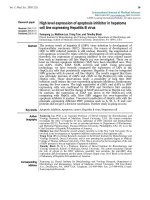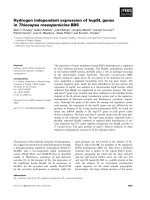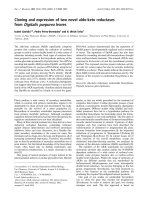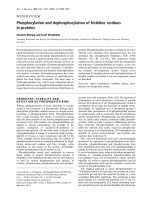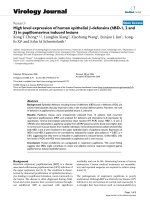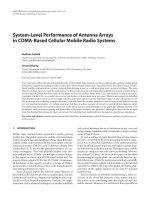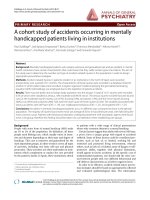Báo cáo y học: "High level expression of apoptosis inhibitor in hepatoma cell line expressing Hepatitis
Bạn đang xem bản rút gọn của tài liệu. Xem và tải ngay bản đầy đủ của tài liệu tại đây (301.26 KB, 6 trang )
Int. J. Med. Sci. 2005 2(1)
30
International Journal of Medical Sciences
ISSN 1449-1907 www.medsci.org 2005 2(1):30-35
©2005 Ivyspring International Publisher. All rights reserved
High level expression of apoptosis inhibitor in hepatoma
cell line expressing Hepatitis B virus
Research paper
Received: 2004.11.01
Accepted: 2005.01.01
Published:2005.01.05
Xuanyong Lu, Matthew Lee, Trang Tran, and Timothy Block
Drexel Institute for Biotechnology and Virology Research, Department of Microbiology and
Immunology, School of Medicine, Drexel University, Doylestown, PA 18901, USA
A
A
b
b
s
s
t
t
r
r
a
a
c
c
t
t
The serious result of hepatitis B (HBV) virus infection is development of
hepatocellular carcinoma (HCC). However, the reason of development of
HCC in HBV infected patients is still unclear. Recently, the suppression of
cell apoptosis is found to relate with the development of cell carcinogenesis,
therefore, the expression of apoptosis inhibitor in the virus related cancer
line such as hepatoma cell line HepG2.215 was investigated. There are at
least six Human apoptosis inhibitors (IAP) have been identified now. They
are cIAP1, cIAP2, XIAP, NAPI, survivin and pIAP. Using gene-assay
technology, we have recently compared the expression of IAPs in the
HepG2.215 cells that persistently expresses Hepatitis B virus by integrated
HBV genome with its parent cell line HepG2. The results suggest that there
was obviously increase of cIAP2 and cIAP1 in the HepG2.215 cells versus
HepG2 cells. Those observations imply a possibility of long time HBV
infection could induce the over-expressing apoptosis inhibitors, furthermore,
causing the liver cancer. The high expression of cIAP1 and cIAP2 in HBV
expressing cells was confirmed by RT-PCR and Northern blot analysis.
However, we did not find the change of NIAP and suvivin in HepG2.215 cells.
In contrast, the expression of XIAP was down in the HepG2.215 cells
comparing with HepG2 cells. How HBV triggers the over-expression of
apoptosis inhibitor is unclear. Transient transfection of HepG2 cells with the
plasmids expressing different HBV proteins such as S, M, L, X and core
proteins did not give a decisive conclusion. Further study is going on now.
K
K
e
e
y
y
w
w
o
o
r
r
d
d
s
s
Apoptosis inhibitor, Apoptosis, cancer, Hepatitis B virus, Hepatoma cell
A
A
u
u
t
t
h
h
o
o
r
r
b
b
i
i
o
o
g
g
r
r
a
a
p
p
h
h
y
y
Xuanyong Lu, PhD is an Assistant Professor of Drexel Institute for Biotechnology and
Virology Research, School of Medicine, Drexel University, USA. His current researches
investigate the entry of hepatitis B virus, pathology of HBV infection and hepatocellular
carcinoma (HCC). Previously he was an assistant professor in Department of Biochemistry
and Molecular Pharmacology, Thomas Jefferson University, Philadelphia, USA. Dr. Lu is the
Chief Scientist of Hepatitis B Foundation of America.
Matthew Lee (Intel Scientific Award winner) currently is in the New York University. He is
involved in the investigation of Apoptosis inhibitor expression in the hepatoma cells.
Trang Tran (BS) is formal Research Assistant in the Drexel Institute for Biotechnology and
Virology Research, Drexel University, and is now pursuing her graduate degree at Medical
College of Thomas Jefferson University, USA. She is involved in the investigation of the role
of HBV proteins in the up-regulation of apoptosis inhibitor.
Timothy Block Ph. D is a Professor, director of Drexel Institute for Biotechnology and
Virology Research, School of Medicine, Drexel University. His current researches include
the role of glycan in the HBV infection, assembly and secretion, the anti-HBV drug
exploration and development and the latent of Herpes simple virus. Prof. Block is the director
of laboratory of Hepatitis B Foundation of America.
C
C
o
o
r
r
r
r
e
e
s
s
p
p
o
o
n
n
d
d
i
i
n
n
g
g
a
a
d
d
d
d
r
r
e
e
s
s
s
s
Xuanyong Lu, Drexel Institute for Biotechnology and Virology Research, Department of
Microbiology and Immunology, School of Medicine, Drexel University. 700 East Butler
Ave., Doylestown, PA, 18901 USA. Telephone: 215-489-4906. Fax: 215-489-4920. E-mail:
Int. J. Med. Sci. 2005 2(1)
31
1. Introduction
Hepatitis B virus (HBV) is a major human pathogen responsible for acute and chronic liver disease. Worldwide, more than 350
million people are chronically infected with HBV and more than one third of these individuals will develop into serious liver
diseases such as primary hepatocellular carcinoma (HCC), if left untreated, which causes an estimated 1 million deaths annually [4].
Therefore, clarification of the relationship of HBV infection and the development of HCC, consequently developing the therapeutic
method, is imperative.
HBV is a small circular DNA virus, containing a nucleocapsid and an envelope. HBV nucleocapsid contains a relatively small
incomplete double stranded DNA genome, viral polymerase and core protein. Its envelope is composed of viral surface proteins
enclosed by a lipid membrane derived from host cells [11, 38], named LHBs, MHBs and SHBs, respectively to Large, middle and
small surface protein [22]. Besides those viral proteins, HBV expresses a small non-structure protean named X protein, its function
is still unclear. The role of HBV protein, particular of middle surface protein and X protein, in cell carcinogenesis is suggested [6,
13, 14, 37, 17, 27], but is far away to the conclusion. Therefore, further investigation is needed.
Recently, the studies have shown that the apoptotic cell death plays an important physiological role for normal cell
development and tissue homeostasis. Dysregulation of apoptosis has been implicated in carcinogenesis, tumor progression and
resistance of tumor cells to radio-and chemotherapy [28]. The molecular pathways leading to apoptosis are evolutionarily conserved
and controlled by proteins that either promote or inhibit activation of a cascade of intracellular cysteine proteases known as caspases.
Caspases can be divided into two groups based on the length of their prodomain and substrate specificity. The initiator caspase
group includes caspase-2, caspase-8, caspase-9, and caspase-10, having long NH2-terminal prodomains, which interact with adapter
molecules to form a death-inducing signaling complex. Downstream caspases such as caspase-3, caspase-6, and caspase-7 are
executioner caspases that remain dormant until the initiator caspases activate them by proteolysis [8]. The activated executioner
caspases cleave a number of structural and regulatory proteins, leading to apoptotic cell death [26].
One kind of proteins that regulate cell apoptosis are named Apoptosis inhibitors (IAP), which include c-IAP1, c-IAP2, XIAP,
NAIP, survivin, and currently discovered pIAP [8, 9, 15, 16, 20, 21, 25, 30, 31]. These proteins contain a novel 80 amino acid motif
that is defined as the Baculovirus IAP repeat (BIR) [20], which probably prevents the proteolytic processing of procaspase-3,
procaspase-6, and procaspase-7 by binding and blocking the activity of caspase-9. Increasing evidence demonstrated that IAPs are
up regulated in many human tumor types and tumor cell lines [ 18, 32, 29, 39, 40] such as pancreatic carcinoma cells, lung cancer
cells [7, 10 ], prostate cancer cells [24] and renal carcinoma cell line [28, 19, 44 ]. Other interesting finding is that the cancer cells
resistant to the radio- and chemotherapy have obviously high level of IAP [3, 19, 36]. However, the reason why these IAPs are over-
expressed in tumor cell is unknown.
Since HBV is a tumor trigger, we are interested in whether HBV could stimulate the over-expression of IAPs. Therefore, we
have compared the IAPs expression in the persistently HBV expressing cell line HepG2.215 and its parent cell line, a non-HBV
expressing cell line HepG2. We found that cIAP1 and cIAP2 were clearly increased in the HBV expressing cells but XIAP was
down regulated. The other two IAPs, NIAP and suvivin, remain unchanged. The results suggest that the long time stimulation of
HBV viral proteins indeed changes the expression of apoptosis profile of host cells, which probably results in the carcinogenesis of
liver cells.
2. Materials and methods
Cell lines and isolation of RNA
HepG2 cell line was bought from ATCC and HepG2.215 cell line, which persistently produces Hepatitis B virus due to the
integrated HBV genome, was kindly provided by Dr. Acs (Mt. Sinai Medical College, NY, NY). Both cell lines have been
maintained in our laboratory for more than 8 years.
Total RNA was isolated from 10
7
HepG2 cells or HepG2.215 cells using total RNA isolation Kit (Stratagene La Jolla, CA
USA) as manufactory instruction. Briefly, cells were lysed with lysis buffer provided with Kit. Cell debris was removed by
filtration. RNA was precipitated with ethanol and caught by RNA binding spin cup. After washing, DNA was degraded by the
digestion of DNase. Finally RNA was released from cup and stored in –70° C for use.
Micro-array analysis
For gene array analysis, 100 µg RNA was reversely transcripted in to cDNA. cDNA fragments from mRNAs were
fluorescently labeled and hybridized with chips contained more than 1,200 relative genes. Signal was detected and quantified.
Mergen LTD (San Francisco, CA) performed the gene array analysis and result comparisons.
Reverse-transcription PCR detection of IAPs
One microgram RNA was used for the reverse-transcription PCR (RT-PCR). The reverse transcription was performed using
RT-PCR kit (Stratagene, La Jolla, CA, USA), following by PCR amplification as described in our paper [22]. The primers with the
sequence 3’-GAGGAGACAGTCCTACTGAAA (API1) and 3’-CATAGCATTATCCTTCGGTTC (API2) were used to detect
cIAP2. Primers with the sequence 3’-GGGAAGCAGAGATCATTTTGC (API3) and 3’- AACTGAGTATATCCATGTCCC
(API4) were used to detect XIAP. PCR bands were resolved in 1% agarose gel and quantified by software of AlphaIntertech.
Northern Blot detection of IAPs RNA
Ten micro grams RNA was resolved by 1% agarose gel electrophoresis. RNA was transferred to nylon membrane for Northern
blot analysis. “Northern” type blotting was performed essentially as described by Lu et al. [23]. The probe was made from PCR
amplification of the plasmid containing IAPs sequence. Briefly, the plasmid containing IAPs DNA sequence was used as a template
for PCR amplification. PCR was performed as described before except for 20µCi 32-P dCTP was used in place of the non-
Int. J. Med. Sci. 2005 2(1)
32
radioactive dCTP [23]. 32-P labeled IAP fragments were purified by Probe Quant G50 micro column (Amersham, Piscataway, NJ).
The membranes were hybridized with IAP probe (>10
7
cpm/ml) at 68° C, overnight. The images were acquired by phosphorimager.
Detection of IAP proteins by immune-precipitation with anti-IAP antibody
HepG2.2.15 cells or HepG2 cells were labeled by 35-S methionine (Amersham, Piscataway. NJ) as described in Lu et al. [23].
Briefly, 10
7
cells were washed with phosphate-buffered saline (PBS) three times, and incubated with 3 ml methionine minus RPMI
1640 medium 30 minutes. Cells were labeled with 100µCi/ml 35-S methionine overnight. After washing with PBS, cells were
released by trypsin digestion and then were lysed with 0.8ml Tris-HCl 0.05M pH 7.5, NaCl 0.15 M, MgCl
2
0.005M, Np-40 0.2% at
room temperature for 30 minutes. The nuclei and cell debris were removed by centrifugation at 14,000 rpm 5 minutes. The lysate
was collected and the radioactivity was determined by Trichloroacetic acid (TCA) precipitation. For protein analysis, 100µl cell
lysate was immune-precipitated with 30µl protein G beads (Roche, Switzerland) at 4° C overnight, which pre-absorbed with
monoclonal anti-IAP antibody (1µg/ ml) (Zymed, Poli Alto, CA). After 4 washings with PBS, 0.05% Tween 20, the IAP proteins
were released from beads through cooking at 95° C, 10 minutes in 20 µl sample buffer and resolved by 12.5 % sodium dodecyl
sulfate polyacrylamide gel electrophoresis (SDS-PAGE). Proteins were transferred to polyvinyl difluoride (PVDF) membrane (Bio-
Rad, Hercules CA) and images were analyzed by Phosphorimager.
3. Results
The profile of IAPs expression in the cells producing HBV
The change of IAPs expression in the HBV expressing cells was first investigated by the comparison of the gene expression
profile in the HepG2.215 and HepG2 cells using gene array technology.
HepG2.215 is a cell line that derives from HepG2. The only difference between them is HepG2.215 cell is able to produce
infectious viruses through the HBV genome integrated in the cell chromosome [1, 34, 35]. The results from gene array suggest that
the expression of cIAP1 and cIAP2 genes was obviously higher in the HepG2.215 cells than in the HepG2 cells, approximately 1.6
folds and 9 folds respectively (Table 1). The strong intensity of the dots implies that the increase of the expression of cIAP2 and
cIAP1 most likely are reliable. In contrast, the gene expression of XIAP seemed to be 21 folds down in the HepG2.215 cells versus
in the HepG2 cells (Table 1). However, the low expression of XIAP in the samples (negative intensity of the dot) probably lessens
the significant of this difference. We will discuss this in detail late. The expression of two other IAPs: NAIP and survivin, have not
shown any changes by gene array (Table 1).
Table 1. Analysis of IAPs expression in the HepG2.215 and HepG2 cells
One hundred micrograms RNA from HepG2.215 and HepG2 cells
were analyzed by gene array (Mergen LTD). The intensity of dots
were calculated and standardized by computer. The comparison was
then performed.
Because the expressions of cIAP2 and XIAP in the cell
line expressing HBV were dramatically altered, therefore, our next investigation focused in these two species.
The up-regulation of cIAP2 in cells expressing HBV
Figure 1. The over-
expression of cIAP2 in the
HBV expressing cell line,
HepG2.215. The RNA from
HepG2.215 and HepG2
cells were isolated. The
expression of cIAP2 was
examined with RT-PCR and
Northern blot. A. RT-PCR
detects cIAP2. One
microgram RNA from
HepG2 (number 1,
duplicate) and HepG2.215
cells (number 2, duplicate)
were reverse- transcripted,
and then amplified by PCR.
The result from PCR was
shown as a 434bp band. β-
Actin was used as a loading
control. B. Northern blot
detects cIAP2. Ten
microgram RNA from
HepG2 (number 1, duplicate) and HepG2.215 cells (number 2, duplicate) were separated by denature gel, then hybridized with
cIAP2 specific probe. The cIAP2 and cIAP1 bands were indicated. β-Actin was used as a loading control as well.
HepG215/HepG2 (Fold) Intensity of dots
cIAP2 9.00 9.0357/-6.739
cIAP1 1.60 67.037/35.824
XIAP -21.9 -5.354/0.0414
NIAP 1.00 -8.353/-11.45
Survivin 1.00 -11.844/-8.3526
cIAP2
Actin
Mar
k
1 2
1 2
1. HepG2 2. HepG2.215
A
434bp
c-IAP2
c-IAP1
4.0Kb
1.9Kb
1. HepG2 2. HepG2.215
1 2
B
Int. J. Med. Sci. 2005 2(1)
33
The increase of gene expression of cIAP2 in HepG2.215 cells was further investigated by the reverse transcription PCR (RT-
PCR) and Northern Blot. Using the specific primer set of IAP1/ IAP2 (See Materials and Methods), which amplifies the cAPI2 gene
fragment from coding number 681 to 1014, a corresponding band with 434 base pairs was generated (Figure 1A). Figure 1A shows
that the expression of cIAP2 was obviously higher in the HepG2.215, a cell line expressing HBV, than in the HepG2, a cell line
absence of HBV (Figure 1A, 1&2). The up-regulation of cIAP2 expression in HepG2.215 cells is not due to an impact upon loading,
at the same condition, the expression of β-Actin in both cell lines remained unchanged (Figure 1A). The up-regulation of cIAP2
expression is consistent with the result from gene array analysis.
The up-regulation of cIAP2 was confirmed by the Northern Blot analysis. After the hybridization with the probe specifying
cIAP2, cIAP2 RNA appeared as a special band located in the place with the molecular weight around 8 kilo-base pair (Kb) (Figure
1B). Because the cIAP2 and cIAP1 have 80% homogenous in their DNA sequence, the probe used to detect cIAP2 may detect the
cIAP1 either [31, 43]. Therefore, the band with molecular weight around 4.5 kilo base pairs detected by cIAP2 probe was expected
as the cIAP1 RNA (Figure 1B, the band below cIAP2 band). The nature of the third band below cIAP1 is unknown. However, it was
also found in the testis cancer cells by Holcik et al. [15]. This band is studying in our laboratory now.
Comparing with the HepG2 cells, the RNA level of cIAP2 in the HepG2.215 cells was obviously higher by the Northern Blot
(Figure 1B, lane 2). This is agreement with the previous results from RT-PCR and gene array analysis. However, the increase of
expression of cIAP1 was also can be observed in the HepG2.215 cells by Northern Blot (Figure 1B, lane 2), despite the cIAP1
expressing level was not stronger as cIAP2. The increase of the expression of cIAP2 and cIAP1 in the HepG2.215 cells were not
due to the unequal loading of the samples, this is supported by the fact that the expression of the β-actin RNA in these samples was
unchanged (Figure 1B).
Detection of XIAP with RT-PCT and Northern Blot
The change of another apoptosis inhibitor XIAP in the HBV expressing cell line was examined by RT-PCR and Northern blot
too. The primer used to specify XIAP was IAP 3&4, which has generated a 575 base pairs band from RT-PCR (Figure 2A). The
result suggests that the expression of XIAP in the HepG2.215 cells was a slightly down in the HBV expressing cell line, HepG2.215.
This supports the conclusion from gene array. However, the noticeable down-regulation of XIAP in the HepG2.215 cell was not
observed in the Northern blot (Figure 2B). Considering the expression of XIAP in the HepG2.215 cell was shown in the level of
lower than background in the gene array (Table 1, intensity of XIAP), it is understandable that the slight decrease of XIAP in the
HepG2.215 cells could be not
detectable by Northern blot.
Figure 2. The Detection of XIAP
in the HepG2.215. The RNA
from HepG2.215 and HepG2
cells were isolated. The
expression of XIAP was
examined with RT-PCR and
Northern blot as described in
Figure 1. A. RT-PCR detects
XIAP. B. Northern blot detects
XIAP. β-Actin was used as a
loading control as well.
The increase of cIAP2 protein in the HBV expressing cells
In order to further investigate the up-regulation of cIAP2 at the translation level, the HepG2.215 cells and HepG2 cells were
metabolically labeled with S
35
methionine. The cIAP2 then was immune-precipitated by
anti-cIAP2 antibody (Zymed Laboratory, San Francisco, CA). Figure 3 shows that despite
the loading of the control β-Actin has not shown difference, the cIAP2 protein with 6.8 kilo
Dolton (KD) molecular weight in the HepG2.215 cells was obviously higher than that one
in the HepG2 cells. This implies that the increase of cIAP2 in the HBV expressing cells was
not only at the transcriptional level but also at the translational level.
The cIAP2 usually forms a heterocomplex with TNF receptor 2 (TNFR2) and its
associated factors: TRAF1 and TRAF2 [31]. Therefore, those proteins might be co-
precipitated with cIAP2 in our experiments. The band located beyond cIAP2 probably was
the 73 KD big TNFR2. The two bands below the cIAP2 band were the 45 KD TRAF1 and
56 KD TRFA2 respectively (Figure 3).
Figure 3. The up-regulation of cIAP2 protein in HepG2.215 cells. HepG2.215 cells were
labeled by 35-S Met. The cIAP2 was immune-precipitated by anti-cIAP2 antibody, and
then resolved in SDS PAGE. The images were analyzed by Phosphorimager.
4. Discussion
The increase of expression of apoptosis inhibitor is thought to be a major cause of the tumor formation/progression. Through
the inhibition of cell apoptosis, cancer cells acquire the ability of unlimited growth. The molecular mechanisms by which the IAPs
exert their antiapoptotic activity have been recently revealed. The main well-characterized mechanism is the inhibition of active
XIAP
β-Actin
Mark
XIAP
12
1 2
1. HepG2 2. HepG2. 215
4.0Kb
1.9Kb
12
575b
p
cIAP
β−Actin
6.8K
4.3K
1. HepG2 2. HepG2. 215
12
Int. J. Med. Sci. 2005 2(1)
34
caspases by the direct binding of IAPs. In the many case, for example, in the lung carcinoma cells, the interaction of the over-
expressed cIAP2 with caspase 9 prevents activating caspase3 that is an executer of apoptosis [10].
One of the ways to stimulate IAPs expression is virus infection. Virus infection can change the host cell gene expression,
furthermore, increasing the level of IAPs as we observed in our results. Some viral protein even itself is an apoptosis inhibitor [31].
In order to determine whether HBV could stimulate IAPs expression, the cell line HepG2.215 that persistently expresses HBV and
its parent cell line HepG2 that does not express HBV were compared. Despite, opposed to normal human liver cell, the abnormal
level of cIAPs expression in HepG2 was observed (our unpublished data), the expression of cIAPs in HepG2.215 cells, particularly
of cIAP2, were much higher than that in HepG2 cells. Because the cIAPs are the important regulators of cell apoptosis, it is possible
that HBV infection might alter the cIAPs gene expressing of liver cell, finally instigating the carcinogenesis of the cells it infected.
This is agreement with the observation that the patients infected by HBV have high risk to develop to hepatocellular carcinoma
(HCC). However, how HBV induces alteration of cIAPs expression, if it is true, what kind of HBV protein plays role in this
alteration is unknown. In an attempt, we have expressed the different HBV proteins such as surface proteins (LHBs, MHBs and
SHBs), core protein and HBV X protein (HBx) in the HepG2 cells respectively. Unfortunately, we did not find any change of the
apoptosis inhibitors in these cells after the transfection (unpublished data). Considering the development of HCC in HBV infected
patients is a long time process, perhaps, transient transfection would not obviously alter the expression of apoptosis inhibitor at all.
Two viral peptides, the HBV X protein and the C-terminus of preS2 domain of surface protein, were found probably
associating with the development of HCC [6, 13, 14, 37, 17]. However, the mechanism of how these proteins contribute to the
carcinogenesis is still in the investigation. The involvement of these proteins in the NF-kB related signal transduction pathway that
results in the cell apoptosis is one of the explanations.
NF-kB, a family of transcription factors, is proven to be closely connected with the cell apoptosis. However, the different NF-
kB transcription factors may play diverse and even opposing roles in modulating cell death by apoptosis. The over-expression of
NF-kB/RelA protects cells from tumor necrosis factor alpha (TNF-a)-or chemotherapy-mediated apoptosis [12, 32]. Enforced
expression of NF-kB/RelA blocks apoptosis induced by a variety of proapoptotic agents, including TNF-a [39, 33]. In contrast, over-
expression of NF-kB/c-Rel in bone marrow cells triggers apoptosis.
The role of HBx in the activation of NF-kB transcription factors is very complex. HBx can activate NF-kB signal transduction
pathway, but the reaction of the cell to HBx is dependent [37]. If HBx induces NF-kB/RelA, it results in the suppression of apoptotic
cell death. In contrast, if HBx induces NF-kB/c-Rel, it promotes apoptotic cell death [37]. However, how HBx triggers different cell
reactions is still unknown. Interestingly, the NF-kB has been shown to up-regulate the expression of cIAP2 and cIAP1 in multiple
cell lines [5, 41, 45]. There is also evidence for cIAP2 induction by NF-kB is some systems [41, 42]. Therefore, it is possible that in
the HBV infected cells, HBx probably activates the NF-kB/RelA, resulting in the up-regulation of IAPs, consequently, triggering the
cell apoptosis. The up-regulation of IAP by NF-kB in the HBV infected cells needs further investigation.
Using the transgenic mice, Hildt and his colleagues found that the PreS2 activators could exert a tumor-promoter-like function
by activation of the PKC/c-Raf-1/MAP2-kinase signaling cascade that is a prerequisite for preS2-dependent activation of AP-1 and
NF-kB [13, 14]. However, the activation of NF-kB transcription factors has been shown to correlate with the cell apoptosis, as we
mentioned before, therefore, the preS2 activator perhaps also is responsible to the up-regulation of cIAPs in the HBV expressing
cells.
Altogether, the development of hepatocellular carcinoma perhaps is a result of long process of multi-genetic change of the
HBV infection. Nevertheless, the discovery of over-expression of cIAPs in the HBV expressing cells gives a possible way to study
the relationship of cell apoptosis and the development of the carcinogenesis.
Acknowledgements
This work was supported by Nucleonics Inc, Horsham, PA, USA; Hepatitis B foundation of America and an appropriation from
the Commonwealth of Pennsylvania.
Conflict of interest
The authors have declared that no conflict of interest exists.
References
1. Acs G, Sells MA, Purcell RH, Price P, Engle R, Shapiro M, Popper H. Hepatitis B virus produced by transfected Hep G2 cells causes hepatitis
in chimpanzees. Proc Natl Acad Sci U S A. 1987, 84 (13): 4641-4.
2. Ambrosini G., Adida C., and Altieri DC. A novel anti-apoptosis gene, survivin, expressed in cancer and lymphoma. Nat. Med., 1997, 3: 917–
921.
3. Antoku K, Liu Z, Johnson DE. Inhibition of caspase proteases by CrmA enhances the resistance of human leukemic cells to multiple
chemotherapeutic agents. Leukemia. 1997, 11(10):1665-72.
4. Beasley RP. The Hepatitis B virus: The major etiology of hepatocellular carcinoma. Cancer, 1988, 61: 1942-1956.
5. C
hu ZL, McKinsey TA, Liu L, Gentry JJ, Malim MH, Ballard DW. Suppression of tumor necrosis factor-induced cell death by inhibitor of
apoptosis c-IAP2 is under NF-kappaB control. Proc Natl Acad Sci U S A. 1997, 94(19):10057-62.
6. Cromlish JA. Links Hepatitis B virus-induced hepatocellular carcinoma: possible roles for HBx. Trends Microbiol. 1996, 4 (7): 270-4.
7. Dai Z, Zhu WG, Morrison CD, Brena RM, Smiraglia DJ, Raval A, Wu YZ, Rush LJ, Ross P, Molina JR, Otterson GA, Plass C. A
comprehensive search for DNA amplification in lung cancer identifies inhibitors of apoptosis cIAP1 and cIAP2 as candidate oncogenes. Hum
Mol Genet. 2003, 12(7): 791-801.
8. Deveraux QL, Stennicke HR, Salvesen GS, Reed JC. Endogenous inhibitors of caspases. J Clin Immunol 1999, 19: 388–98.
9. Duckett CS, Nava VE, et al. A conserved family of cellular genes related to the baculovirus iap gene and encoding apoptosis inhibitors.
EMBO J. 1996, 15: 2685-2689.
10. Ekedahl J, Joseph B, Grigoriev MY, Muller M, Magnusson C, Lewensohn R, Zhivotovsky B. Expression of inhibitor of apoptosis proteins in
small- and non-small-cell lung carcinoma cells. Exp Cell Res. 2002, 279(2): 277-90.
11. Ganem D. Assembly of hepadnaviral virions and subviral particles. Current Topics in Microbiology and Immunology. 1991, 168: 61-83.
